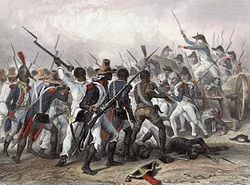
Back قضية الولايات المتحدة ضد الأميستاد Arabic Vzpoura na lodi Amistad Czech Amistad-Prozesse German ארצות הברית נגד לה אמיסטאד HE Processo contro l'Amistad Italian アミスタッド号事件 Japanese 아미스타드 선상반란 Korean Verenigde Staten v. Libellants and Claimants of the Schooner Amistad Dutch Caso Amistad (1841) Portuguese
| United States v. The Amistad | |
|---|---|
 | |
| Argued February 22 – March 2, 1841 Decided March 9, 1841 | |
| Full case name | The United States, Appellants, v. The Libellants and Claimants of the schooner Amistad, her tackle, apparel, and furniture, together with her cargo, and the Africans mentioned and described in the several libels and claims, Appellees. |
| Citations | 40 U.S. 518 (more) |
| Case history | |
| Prior | United States District Court for the District of Connecticut rules for the Africans; United States appeals to the United States Circuit Court for the District of Connecticut, lower court affirmed; United States appeals to the U.S. Supreme Court |
| Subsequent | Africans returned to Africa not by way of the President, but by way of abolitionists; United States Circuit Court for the District of Connecticut dispenses monetary awards mandated by the Supreme Court; United States Circuit Court for the District of Connecticut hears a petition by Ramon Bermejo, in 1845, for the unclaimed monetary sum retained by the court in 1841; petition granted in the amount of $631 |
| Holding | |
| The Africans are free, and are remanded to be released; Lt. Gedney's claims of salvage are granted, remanded to the United States Circuit Court for the District of Connecticut for further proceedings in monetary manners. | |
| Court membership | |
| |
| Case opinions | |
| Majority | Story, joined by Taney, Thompson, McLean, Wayne, Catron, McKinley |
| Dissent | Baldwin |
| Barbour took no part in the consideration or decision of the case. | |
| Laws applied | |
| Pinckney's Treaty, art. IX; Adams-Onís Treaty | |
| Part of a series on |
| North American slave revolts |
|---|
 |
United States v. Schooner Amistad, 40 U.S. (15 Pet.) 518 (1841), was a United States Supreme Court case resulting from the rebellion of Africans on board the Spanish schooner La Amistad in 1839.[1] It was an unusual freedom suit that involved international diplomacy as well as United States law. The historian Samuel Eliot Morison described it in 1969 as the most important court case involving slavery before being eclipsed by that of Dred Scott v. Sandford in 1857.[2]
La Amistad was traveling along the coast of Cuba on her way to a port for re-sale of the slaves. The Africans, Mende people who had been kidnapped in the area of Sierra Leone, in West Africa, illegally sold into slavery and shipped to Cuba, escaped their shackles and took over the ship. They killed the captain and the cook; two other crew members escaped in a lifeboat. The Mende directed the two Spanish navigator survivors to return them to Africa. The crew tricked them by sailing north at night. La Amistad was later apprehended near Long Island, New York, by the United States Revenue-Marine (later renamed the United States Revenue Cutter Service and one of the predecessors of the United States Coast Guard) and taken into custody. The widely publicized court cases in the U.S. federal district court and eventually the Supreme Court in Washington, D.C., in 1841, which addressed international issues, helped the abolitionist movement.
In 1840, a federal district court found that the transport of the kidnapped Africans across the Atlantic Ocean on the Portuguese slave ship Tecora was in violation of US laws against international slave trade. The captives were ruled to have acted as free men when they fought to escape their kidnapping and illegal confinement. The court ruled the Africans were entitled to take whatever legal measures necessary to secure their freedom, including the use of force. Under international and Southern sectional pressure, U.S. President Martin Van Buren ordered the case appealed to the Supreme Court. It affirmed the lower district court ruling on March 9, 1841, and authorized the release of the Mende, but it overturned the additional order of the lower court to return them to Africa at government expense. Supporters arranged for temporary housing of the Africans in Farmington, Connecticut, as well as funds for travel. In 1842, the 35 who wanted to return to Africa, together with U.S. Christian missionaries, were transported by ship to Sierra Leone.
© MMXXIII Rich X Search. We shall prevail. All rights reserved. Rich X Search